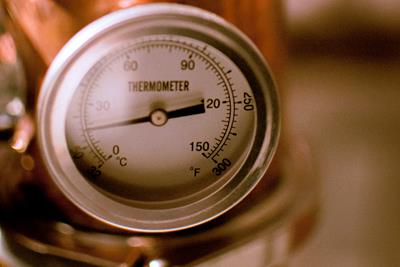
Friday January 6, 2017
By Morgan Smith
 Education
Education
Welcome to one of the newest production trends in concentrates. But be wary, with a potency of nearly 99%, cannabis distillate is not for the new and inexperienced. Generally speaking, cannabis concentrates isolate or separate cannabinoids like THC and CBD to create a pure and refined final product that goes above and beyond an average flower with 15-25% THC content. More recently, there’s been a surge in distillate—a clean and clear concentrate product with up to 99% activated THC.
Just how exactly does distillate vary from other concentrates though? Distillates use an extraction process called “short path distillation” that separates and refines molecules and contaminants to create a clean, almost clear concentrate. Other extraction methods don’t produce nearly the same purity level or variety of uses as this technique, making it highly regarded as a “top-shelf” concentrate.
Discussing the Science
Cannabinoids have rather high boiling points, so manufacturers can distill at much lower temperatures than a typical molecular distillation process. A variety of extraction methods have been developed for decades within the industry, the most common of which use the solvents butane, propane, CO2 and alcohol.
What’s a solvent? A solvent is essentially any chemical liquid that dissolves a product into a solution. Propane hash oil (PHO) or butane hash oil (BHO) are produced with extraction methods that use these specific elements to extract the raw oil from the plant. After discovering the potential with these processes, there are now various BHO concentrate consistencies such as shatter, budder, sap and sugar.
But products like BHO and PHO typically leave residues, impurities and microscopic amounts of unwanted materials in the end product. Cannabis distillates, however, are created using a short path distillation technique that differs from typical solvent extraction. Heat vaporizes THC and CBD, bringing the vapor into a cooling system for consolidation and eventual collection into beakers. This process is repeated over and over again to create pure cannabinoids without chlorophyll, plant matter or residual solvents.

Understanding Naming Conventions
That means that concentrates like distillates are considered to be “solvent-free.” The extracted cannabinoids (THC, CBD, etc. and terpenes) are re-infused into the concentrates to create a completely pure product. Even though they were extracted with a hydrocarbon solvent, solvent-free products have zero parts-per-million (ppm) residual solvent and are highly transparent.
This is why cannabis distillates have been named “The Clear,” or “The Pure.” Distillates are transparent, clear and visually represent a high level of purity. Many people are drawn to the consistency of distillates because they are unlike the most common concentrates on the market.
Alternatively, there are some extraction methods that do not use hydrocarbons and are considered to produce non-solvent products. Full-melt hash, bubble hash and flower rosin are examples of plants that are either washed or pressed to extract trichomes cannabinoids. Because of the extraction method, there is sometimes plant matter left and it can leave an unpleasant taste or residue when dabbed.
It is important to note that non-solvent and solvent-free are completely different terms and describe completely different products. Always be sure to consider the naming conventions of the product you are buying so you can understand the extraction process and what you are putting in to your body.
Terpene Content
When it comes to short path distillation, the end product has no measurable amount of terpene content. The cannabis terpenes are generally lost in the extraction process due to the amount of heat used. But extractors are starting to introduce terpenes into the process after extraction to create specialized and sought after flavors.
This customization option has prompted a bit of a debate within the cannabis community since, as stated above, most distillation extraction methods simply destroy the natural cannabis terpenes throughout the process. It’s been argued that extractors who opt to add foreign terpenes back into the product are altering the raw product and its original make-up.
Many companies are taking advantage of the terpene add-in option though due to the large consumer appeal and ability to add new and exciting flavors to their concentrate experience. Denver-based Organa’s Bakked distillate has up to 97% activated THC, but still has a high-flavor profile thanks to high levels of terpenes and other cannabinoids.
Because of the extended extraction and refinement process, as well as advanced machinery needed to produce distillates, it’s no surprise that they are typically more expensive than other concentrate varieties. The extreme level of purity and potency cannot be compared to different concentrates though, which is why we think every concentrate connoisseur should give them a try.
Photo Credit: Capital Spirits







